 With talks ongoing about resolving the Greek debt crisis, it is clear that there is no agreement that will satisfy both sides – the Greek government and the troika of lenders (the IMF, the ECB and the European Commission). Their current negotiating positions are irreconcilable. What is needed is something more fundamental to provide a long-term solution. What is needed is a ‘deus ex machina‘.
With talks ongoing about resolving the Greek debt crisis, it is clear that there is no agreement that will satisfy both sides – the Greek government and the troika of lenders (the IMF, the ECB and the European Commission). Their current negotiating positions are irreconcilable. What is needed is something more fundamental to provide a long-term solution. What is needed is a ‘deus ex machina‘.
A deus ex machina, which is Latin for ‘god from a machine’, was a device used in Greek tragedy to solve an impossible situation. A god would appear from above, lowered by a crane, or from below through a trap door, and would put everything right. The tragedy would then be given a happy ending.
So what possible happy ending could be brought to the current Greek tragedy and who could be the deus ex machina?
 The negotiations between Greece and the troika currently centre on extending credit by €7.2bn when existing debts come up for repayment. There are repayments currently due to the IMF, or by the end of June, of €1.5bn and more in July, September and December (another €3.2bn). There are also €6.7bn of Greek bonds held by the ECB, as part of the 2010 bailout programme, that are due for repayment in July and August. Without the €7.2 billion bailout, Greece will be unable to meet these debt repayments, which also include Treasury bills.
The negotiations between Greece and the troika currently centre on extending credit by €7.2bn when existing debts come up for repayment. There are repayments currently due to the IMF, or by the end of June, of €1.5bn and more in July, September and December (another €3.2bn). There are also €6.7bn of Greek bonds held by the ECB, as part of the 2010 bailout programme, that are due for repayment in July and August. Without the €7.2 billion bailout, Greece will be unable to meet these debt repayments, which also include Treasury bills.
But the troika will only release the funds in return for harsh austerity measures, which involve further cuts to pensions and public expenditure. Greece would be required to run a substantial budget surplus for many years.
Greece could refuse, but then it would end up defaulting on debt and be forced out of the euro. The result would probably be a substantial depreciation of a newly restored drachma, rising inflation and many Greeks suffering even greater hardship – at least for a period of time.
 So what is the possible deus ex machina? If you’re looking for a ‘god’ then it is best, perhaps, to look beyond the current actors. Perhaps the Americans could play the role in finding a solution to the impasse. Perhaps a small group of independent experts or politicians, or both, could find one. In either case, the politics of the situation would have to be addressed as well as the economics and finance.
So what is the possible deus ex machina? If you’re looking for a ‘god’ then it is best, perhaps, to look beyond the current actors. Perhaps the Americans could play the role in finding a solution to the impasse. Perhaps a small group of independent experts or politicians, or both, could find one. In either case, the politics of the situation would have to be addressed as well as the economics and finance.
And what would be the ‘fix’ to satisfy both sides? Ultimately, this has to allow Greek debt to be sustainable without further depressing demand and undermining the fabric of Greek society.  This would almost certainly have to involve a large measure of debt forgiveness (i.e. debts being written off). It also has to avoid creating a moral hazard, whereby if the Greeks are seen as being ‘let off lightly’, this might encourage other indebted eurozone countries to be less willing to reduce their debts and make demands for forgiveness too.
This would almost certainly have to involve a large measure of debt forgiveness (i.e. debts being written off). It also has to avoid creating a moral hazard, whereby if the Greeks are seen as being ‘let off lightly’, this might encourage other indebted eurozone countries to be less willing to reduce their debts and make demands for forgiveness too.
Ultimately, the issue is a political one, not an economic one. This will require clever negotiation and, if there is a deus ex machina, clever mediation too.
Videos
 Greek PM Tsipras warns lenders bailout plans ‘not realistic’ BBC News, Jim Reynolds (5/6/25)
Greek PM Tsipras warns lenders bailout plans ‘not realistic’ BBC News, Jim Reynolds (5/6/25)
 Greece defers IMF payment until end of June BBC News, Chris Morris (5/6/15)
Greece defers IMF payment until end of June BBC News, Chris Morris (5/6/15)
 Greek debt talks: Empty shops and divided societies BBC News, Chris Morris (10/6/15)
Greek debt talks: Empty shops and divided societies BBC News, Chris Morris (10/6/15)
 Potential Grexit effects Deutsche Welle (13/6/15)
Potential Grexit effects Deutsche Welle (13/6/15)
Articles
It’s time to end the pretence: Greece will never fully repay its bailout loan The Guardian, Andrew Farlow (9/6/15)
Greek exit would trigger eurozone collapse, says Alexis Tsipras The Guardian, Phillip Inman, Helena Smith and Graeme Wearden (9/6/15)
The eurozone was a dream of unity. Now Europe has turned upon itself The Guardian, Business leader (14/6/15)
Greece bailout talks: an intractable crisis with three possible outcomes The Guardian, Larry Elliott (2/6/15)
Greece needs an economic defibrillator and a debt write-off Financial Times letters, Ray Kinsella (25/3/15)
Greece’s new debt restructuring plan Times of Change, Peter Spiegel (5/6/15)
Eurozone still in denial about Greece BBC News, Robert Peston (3/6/15)
Greece bailout talks – the main actors in a modern-day epic The Guardian, Phillip Inman, Ian Traynor and Helena Smith (9/6/15)
Greece isn’t any old troubled debtor BBC News, Robert Peston (15/6/15)
Greece in default if debt deadline missed, says Lagarde BBC News (18/6/15)
Burden of debt to IMF and European neighbours proves too much for Greece The Guardian, Heather Stewart (17/6/15)
Paper
Ending the Greek Crisis: Debt Management and Investment led Growth Greek government
Questions
- To which organisations is Greece indebted? What form to the debts take?
- To what extent is Greece’s current debt burden the result of design faults of the euro?
- Would it be possible to restructure debts in ways that make it easier for Greece to service them?
- Should Greece be treated by the IMF the same way it treated the highly indebted poor countries (HIPCs) and granted substantial debt relief?
- What would be the effects of Greek exit from the euro (a) for Greece; (b) for other eurozone countries?
- What bargaining chips can Greece deploy in the negotiations?
- Explain what is meant by ‘moral hazard’. Where in possible outcomes to the negotiations may there be moral hazard?
- What has been the impact of Greek austerity measures on the distribution of income and wealth in Greece?
- What are the practicalities of pursuing supply-side policies in Greece without further dampening aggregate demand?
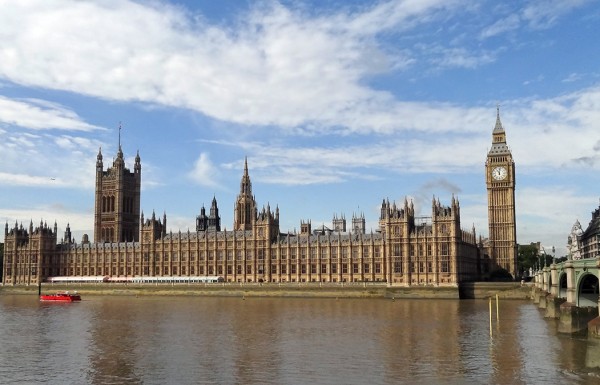 In their manifestos, the parties standing for the UK general election on May 7th state their plans for fiscal policy and, more specifically, for reducing public-sector net borrowing and public-sector net debt. The degree of detail in the plans varies, especially with regards to where cuts will be made, but there are nevertheless some very clear differences between the parties.
In their manifestos, the parties standing for the UK general election on May 7th state their plans for fiscal policy and, more specifically, for reducing public-sector net borrowing and public-sector net debt. The degree of detail in the plans varies, especially with regards to where cuts will be made, but there are nevertheless some very clear differences between the parties.
The Institute for Fiscal Studies has examined the public finance plans of the Conservatives, Labour, Liberal Democrats and SNP and has published a briefing note (see link below) and an accompanying press release. It accuses all four parties’ plans of being short on detail over specific cuts (especially the Conservatives), and over borrowing requirements (especially Labour):
None of these parties has provided anything like full details of their fiscal plans for each year of the coming parliament, leaving the electorate somewhat in the dark as to both the scale and composition of likely spending cuts and tax increases. In our analysis we have used the information provided in each manifesto, plus in some cases some necessary assumptions, to shed light on the four parties’ plans.
But despite the lack of detail, the IFS claims that there are big differences in the parties’ plans. These are illustrated in the following three charts from the IFS Briefing Note.

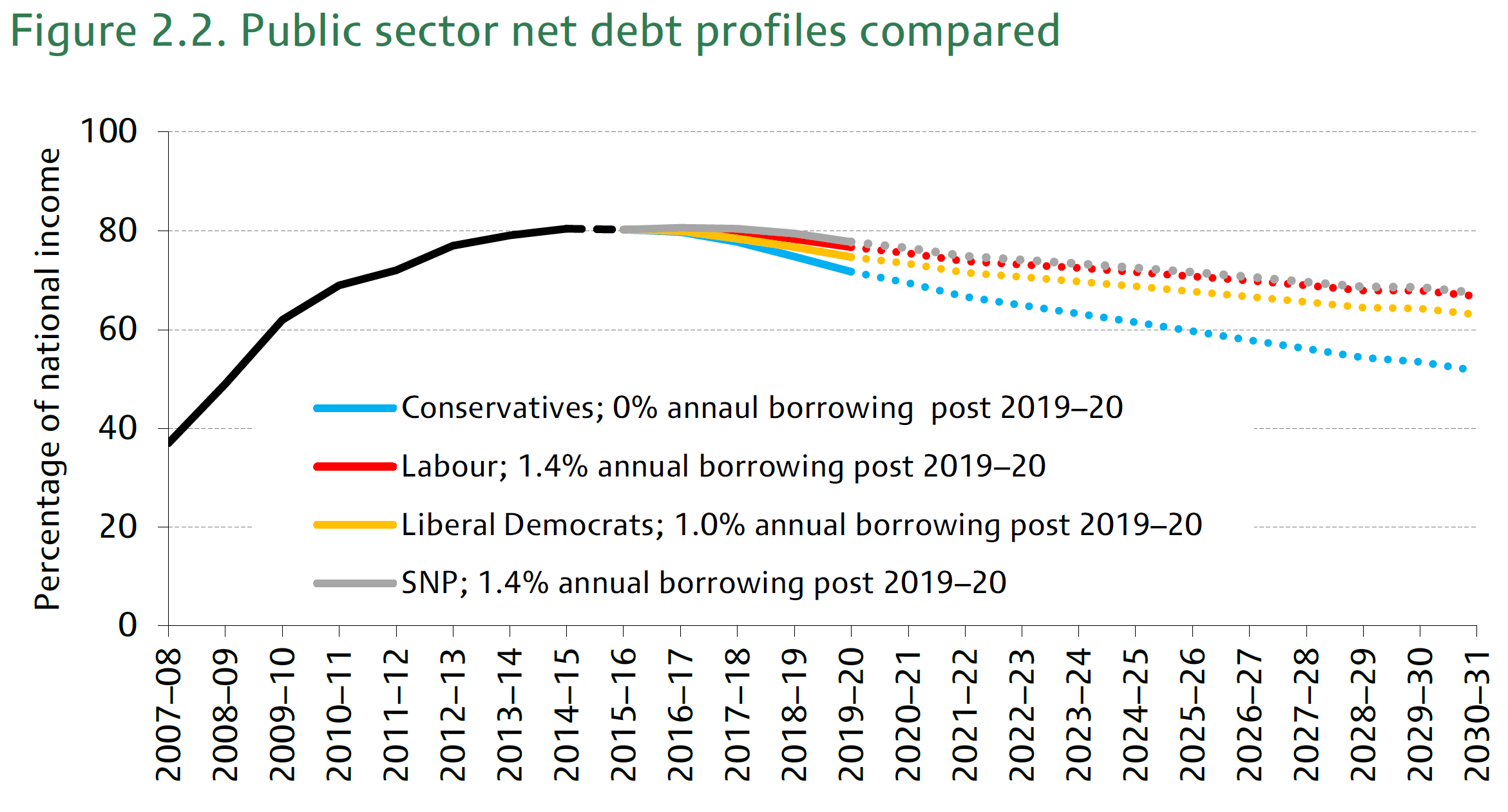
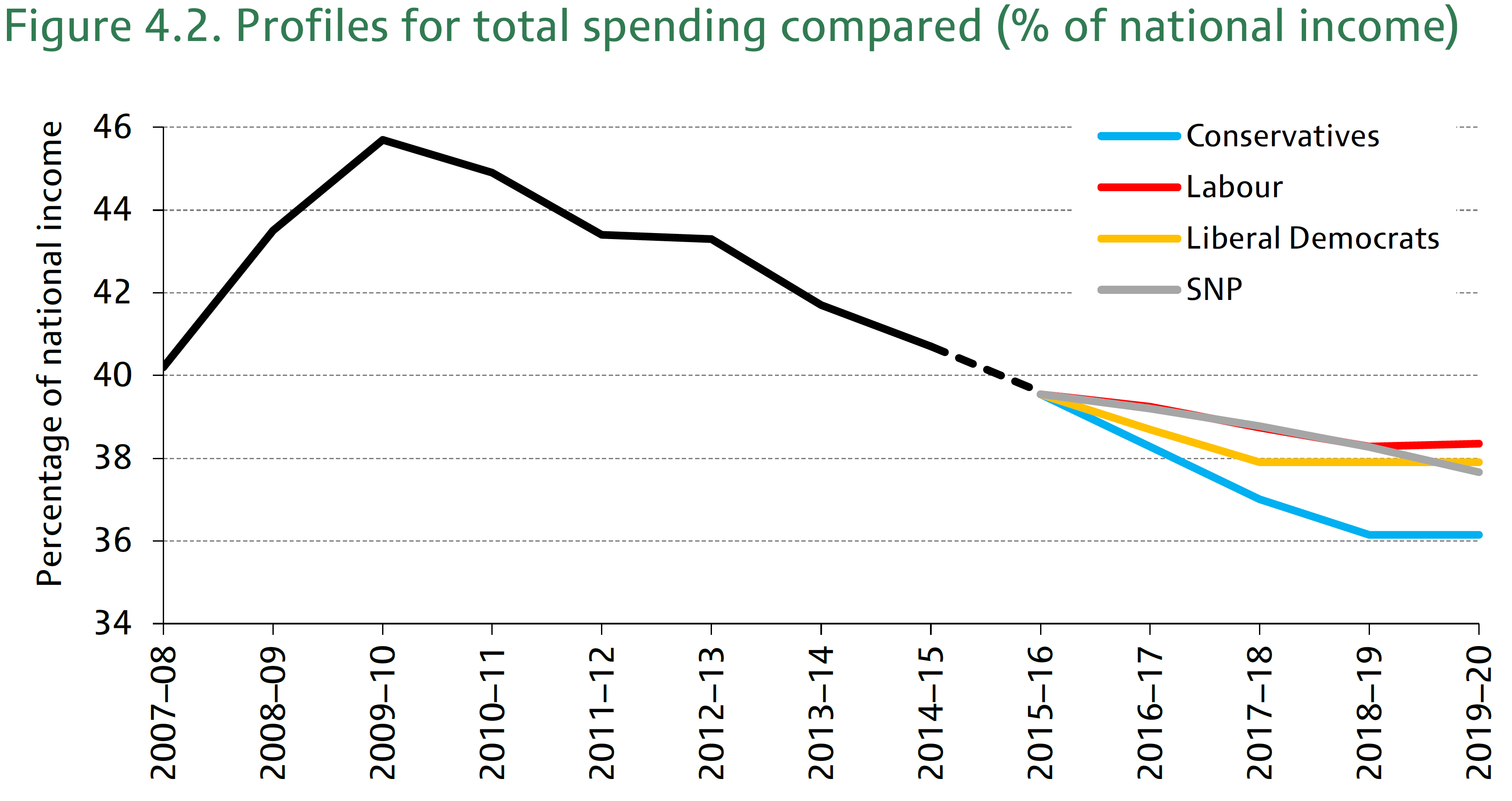
According to Carl Emmerson, IFS deputy director:
“There are genuinely big differences between the main parties’ fiscal plans. The electorate has a real choice, although it can at best see only the broad outlines of that choice. Conservative plans involve a significantly larger reduction in borrowing and debt than Labour plans. But they are predicated on substantial and almost entirely unspecified spending cuts and tax increases. While Labour has been considerably less clear about its overall fiscal ambitions its stated position appears to be consistent with little in the way of further spending cuts after this year”.
So what would be the implications of the plans of the various parties for fiscal policy and what, in turn, would be the implications for economic growth and investment? The various videos and articles look at the briefing note and at what is missing from the parties’ plans.
Videos
 Voters ‘in the dark’ over budgets BBC News, Robert Peston (23/4/15)
Voters ‘in the dark’ over budgets BBC News, Robert Peston (23/4/15)
 Election 2015: Main parties respond to IFS deficit claims BBC News, James Landale (23/4/15)
Election 2015: Main parties respond to IFS deficit claims BBC News, James Landale (23/4/15)
 Election 2015: ‘Not enough detail’ on deficit cut plans, says IFS BBC News, Paul Johnson (23/4/15)
Election 2015: ‘Not enough detail’ on deficit cut plans, says IFS BBC News, Paul Johnson (23/4/15)
 IFS: Electorate ‘left in the dark’ by political parties ITV News, Chris Ship (23/4/15)
IFS: Electorate ‘left in the dark’ by political parties ITV News, Chris Ship (23/4/15)
 Voters Left In Dark Over Spending Cuts, Says IFS Sky News (23/4/15)
Voters Left In Dark Over Spending Cuts, Says IFS Sky News (23/4/15)
 Post-election austerity: parties’ plans compared Institute for Fiscal Studies, Press Briefing (23/5/15)
Post-election austerity: parties’ plans compared Institute for Fiscal Studies, Press Briefing (23/5/15)
Articles
IFS: election choice is stark Economia, Oliver Griffin (23/4/15)
Election 2015: Voters ‘left in the dark’, says IFS BBC News (23/4/15)
The huge choice for voters BBC News, Robert Peston (23/4/15)
IFS manifesto analysis: fantasy island of Tory deficit reduction plan The Guardian, Larry Elliott (23/4/15)
Tories have £30bn black hole in spending plans, says IFS The Guardian, Heather Stewart (23/4/15)
Ed Miliband will leave Britain an extra £90bn in debt, IFS finds The Telegraph, Steven Swinford (23/4/15)
IFS despairs as it finds no party’s imaginary numbers add up The Guardian, John Crace (23/4/15)
Reality Check: Why should we trust the IFS? BBC News, Sebastian Chrispin (23/4/15)
IFS: Households can expect lower incomes, whoever wins the election BBC News, Brian Milligan (28/4/15)
Briefing Notes
Post-election Austerity: Parties’ Plans Compared Institute for Fiscal Studies, Briefing Note BN170, Rowena Crawford, Carl Emmerson, Soumaya Keynes and Gemma Tetlow (April 15)
Taxes and Benefits: The Parties’ Plans Institute for Fiscal Studies, Briefing Notw BN 172, Stuart Adam, James Browne, Carl Emmerson, Andrew Hood, Paul Johnson, Robert Joyce, Helen Miller, David Phillips, Thomas Pope and Barra Roantree (April 2015)
Questions
- What detail is missing about cuts in the Conservative plans?
- What detail is missing in the Labour plans on borrowing requirements?
- How do (a) the Liberal Democrat plans and (b) the SNP plans differ from Conservative and Labour plans?
- Find out the public finances plans of (a) the Green Party; (b) UKIP; and (c) Plaid Cymru. How different are these plans from those of other parties?
- Define ‘austerity’.
- How would a tightening of fiscal policy affect economic growth (a) in the short term; (b) in the long term?
- How would an expansion of the economy affect the budget balance through automatic fiscal stabilisers?
- What is meant by the structural deficit? How could this be reduced?
- Would the structural deficit be affected by austerity policies and the resulting size of the output gap, or is it independent of such policies? Explain.
 ‘The world is sinking under a sea of debt, private as well as public, and it is increasingly hard to see how this might end, except in some form of mass default.’ So claims the article below by Jeremy Warner. But just how much has debt grown, both public and private? And is it of concern?
‘The world is sinking under a sea of debt, private as well as public, and it is increasingly hard to see how this might end, except in some form of mass default.’ So claims the article below by Jeremy Warner. But just how much has debt grown, both public and private? And is it of concern?
The doomsday scenario is that we are heading for another financial crisis as over leveraged banks and governments could not cope with a collapse in confidence. Bank and bond interest rates would soar and debts would be hard to finance. The world could head back into recession as credit became harder and more expensive to obtain. Perhaps, in such a scenario, there would be mass default, by banks and governments alike. This could result in a plunge back into recession.
The more optimistic scenario is that private-sector debt is under control and in many countries is falling (see, for example, chart 1 in the blog Looking once again through Minsky eyes at UK credit numbers for the case of the UK). Even though private-sector debt could rise again as the world economy grows, it would be affordable provided that interest rates remain low and banks continue to build the requisite capital buffers under the Basel III banking regulations.
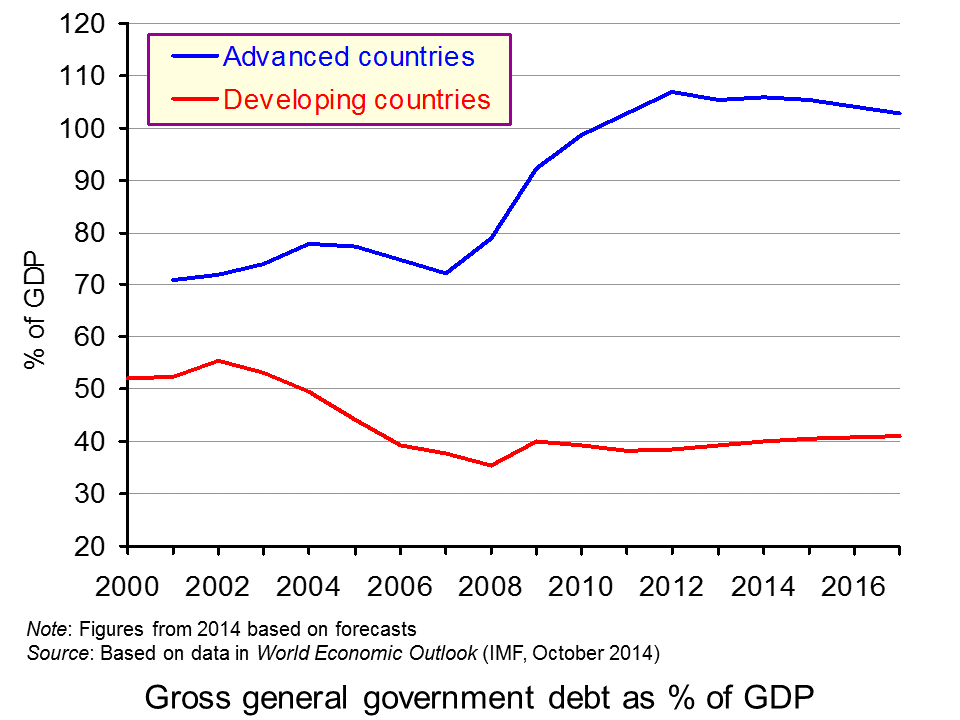 As far as public-sector debt is concerned, as a percentage of GDP its growth has begun to decline in advanced countries as a whole and, although gently rising in developing and emerging economies as a whole, is relatively low compared with advanced countries (see chart). Of course, there are some countries that still face much larger debts, but in most cases they are manageable and governments have plans to curb them, or at least their growth.
As far as public-sector debt is concerned, as a percentage of GDP its growth has begun to decline in advanced countries as a whole and, although gently rising in developing and emerging economies as a whole, is relatively low compared with advanced countries (see chart). Of course, there are some countries that still face much larger debts, but in most cases they are manageable and governments have plans to curb them, or at least their growth.
But there have been several warnings from various economists and institutes, as we saw in the blog post, Has the problem of excess global debt been tackled? Not according to latest figures. The question is whether countries can grow their way out of the problem, with a rapidly rising denominator in the debt/GDP ratios.
Only mass default will end the world’s addiction to debt The Telegraph, Jeremy Warner (3/3/15)
Questions
- What would be the impact of several countries defaulting on debt?
- What factors determine the likelihood of sovereign defaults?
- What factors determine the likelihood of bank defaults?
- What is meant by ‘leverage’ in the context of (a) banks; (b) nations?
- What are the Basel III regulations? What impact will they have/are they having on bank leverage?
- Expand on the arguments supporting the doomsday scenario above.
- Expand on the arguments supporting the optimistic scenario above.
- What is the relationship between economic growth and debt?
- Explain how the explosion in global credit might merely be ‘the mirror image of rising output, asset prices and wealth’.
- Is domestic inflation a good answer for a country to the problems of rising debt denominated (a) in the domestic currency; (b) in foreign currencies?
 According to a report by the McKinsey Global Institute, global debt is now higher than before the financial crisis. And that crisis was largely caused by excessive lending. As The Telegraph article linked below states:
According to a report by the McKinsey Global Institute, global debt is now higher than before the financial crisis. And that crisis was largely caused by excessive lending. As The Telegraph article linked below states:
The figures are as remarkable as they are terrifying. Global debt – defined as the liabilities of governments, firms and households – has jumped by $57 trillion, or 17% of global GDP, since the fourth quarter of 2007, which was supposed to be the peak of the bad old credit-fuelled days. In 2000, total debt was worth 246% of global GDP; by 2007, this had risen to 269% of GDP and today we are at 286% of GDP.
This is not how policy since the financial crisis was supposed to have worked out. Central banks and governments have been trying to encourage greater saving and reduced credit as a percentage of  GDP, a greater capital base for banks, and reduced government deficits as a means of reducing government debt. But of 47 large economies in the McKinsey study, only five have succeeded in reducing their debt/GDP ratios since 2007 and in many the ratio has got a lot higher. China, for example, has seen its debt to GDP ratio almost double – from 158% to 282%, although its government debt remains low relative to other major economies.
GDP, a greater capital base for banks, and reduced government deficits as a means of reducing government debt. But of 47 large economies in the McKinsey study, only five have succeeded in reducing their debt/GDP ratios since 2007 and in many the ratio has got a lot higher. China, for example, has seen its debt to GDP ratio almost double – from 158% to 282%, although its government debt remains low relative to other major economies.
Part of the problem is that the lack of growth in many countries has made it hard for countries to reduce their public-sector deficits to levels that will allow the public-sector debt/GDP ratio to fall.
In terms of the UK, private-sector debt has been falling as a percentage of GDP. But this has been more than offset by a rise in the public-sector debt/GDP ratio. As Robert Peston says:
[UK indebtedness] increased by 30 percentage points, to 252% of GDP (excluding financial sector or City debts) – as government debts have jumped by 50 percentage points of GDP, while corporate and household debts have decreased by 12 and 8 percentage points of GDP respectively.
So what are the likely consequences of this growth in debt and what can be done about it? The articles and report consider these questions.
Articles
Instead of paying down its debts, the world’s gone on another credit binge The Telegraph, Allister Heath (5/2/15)
Global debts rise $57tn since crash BBC News, Robert Peston (5/2/15)
China’s Total Debt Load Equals 282% of GDP, Raising Economic Risks The Wall Street Journal, Pedro Nicolaci da Costa (4/2/15)
Report
Debt and (not much) deleveraging McKinsey Global Institute, Richard Dobbs, Susan Lund, Jonathan Woetzel, and Mina Mutafchieva (February 2015)
Questions
- Explain what is meant by ‘leverage’.
- Why does a low-leverage economy do better in a downturn than a high-leverage one?
- What is the relationship between deficits and the debt/GDP ratio?
- When might an increase in debt be good for an economy?
- Comment on the statement in The Telegraph article that ‘In theory, debt is fine if it is backed up by high-quality collateral’.
- Why does the rise is debt matter for the global economy?
- Is it possible for (a) individual countries; (b) all countries collectively to ‘live beyond their means’ by consuming more than they are producing through borrowing?
- What is the structure of China’s debt and what problems does this pose for the Chinese economy?
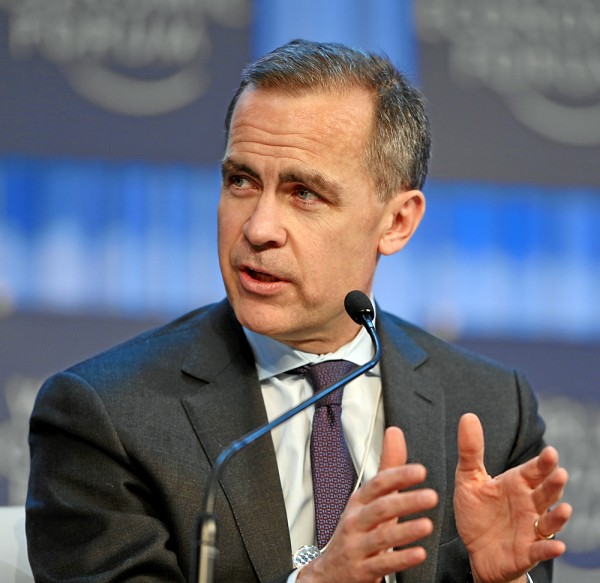 In a speech in Dublin on 28 January 2015, titled ‘Fortune favours the bold‘, Mark Carney, the Governor of the Bank of England, compared the UK economy to that of the 19-nation eurozone. While he welcomed the ECB’s recently announced quantitative easing programme, he argued that the current construction of the eurozone is unfinished and still has two fundamental weaknesses that have not been addressed.
In a speech in Dublin on 28 January 2015, titled ‘Fortune favours the bold‘, Mark Carney, the Governor of the Bank of England, compared the UK economy to that of the 19-nation eurozone. While he welcomed the ECB’s recently announced quantitative easing programme, he argued that the current construction of the eurozone is unfinished and still has two fundamental weaknesses that have not been addressed.
The first is the fragmented nature of banking:
With limited cross-border banking in the euro area, savings don’t flow to potential investments. Euro-area corporates’ cash balances have risen to the tune of €420 billion, or 3% of GDP, since the crisis, for example. Modest cross-border equity flows mean inadequate risk sharing.
The second is the lack of an integrated fiscal policy.
For complete solutions to both current and potential future problems, the sharing of fiscal risks is required.
It is no coincidence that effective currency unions tend to have centralised fiscal authorities whose spending is a sizeable share of GDP – averaging over a quarter of GDP for advanced countries outside the euro area.
… If the eurozone were a country, fiscal policy would be substantially more supportive. However, it is tighter than in the UK, even though Europe still lacks other effective risk sharing mechanisms and is relatively inflexible. A more constructive fiscal policy would help recycle surplus private savings and mitigate the tail risk of stagnation. It would also bridge the drag from structural reforms on nominal spending and would be consistent with the longer term direction of travel towards greater integration.
and is relatively inflexible. A more constructive fiscal policy would help recycle surplus private savings and mitigate the tail risk of stagnation. It would also bridge the drag from structural reforms on nominal spending and would be consistent with the longer term direction of travel towards greater integration.
But fiscal integration requires a political will to transfer fiscal surpluses from the stronger countries, such as Germany, to the weaker countries, such as those in southern Europe.
Overall, the financial and fiscal position in the eurozone is strong:
Gross general government debt in the euro area is roughly the same as in the UK and below the average of advanced economies. The weighted average yield on 10-year euro area sovereign debt is around 1%, compared to 1½% in the UK. And yet, the euro area’s fiscal deficit is half that in the UK. Its structural deficit, according to the IMF, is less than one third as large.
But, unlike the UK, where, despite the rhetoric of austerity, automatic fiscal stabilisers have been allowed to work and the government has accepted a much slower than planned reduction in the deficit, in the eurozone fiscal policy remains tight. Yet unemployment, at 11½%, is twice the rate in the UK and economic growth, at around 0.7% is only one-quarter of that in the UK.
Without a eurozone-wide fiscal policy the problem of slow growth is likely to persist for some time. Monetary policy in the form of QE will help and structural reforms will help to stimulate potential output and long-term growth, but these policies could be much more effective if backed up by fiscal policy.
Whether they will be any time soon is a political question.
Speech
Fortune favours the bold Bank of England. Mark Carney (29/1/15)
Articles
Bank of England’s Carney urges Europe to take plunge on fiscal union Reuters, Padraic Halpin (28/1/15)
Bank Of England’s Mark Carney Attacks ‘Timid’ Eurozone Recovery Attempts Huffington Post, Jack Sommers (29/1/15)
BoE’s Mark Carney calls for common eurozone fiscal policies Financial Times, Ferdinando Giugliano (28/1/15)
Carney attacks German austerity BBC News, Robert Peston (28/1/15)
Bank of England governor attacks eurozone austerity The Guardian, Larry Elliott (28/1/15)
Questions
- Compare the financial and fiscal positions of the UK and the eurozone.
- In what way is there a ‘debt trap’ in the eurozone?
- What did Mark Carney mean when he said, ‘Cross-border risk-sharing through the financial system has slid backwards.’?
- What options are there for the eurozone sharing fiscal risks?
- What would a ‘more constructive’ fiscal policy, as advocated by Mark Carney, look like?
- How do the fiscal policies of other currency unions, such as the UK (union of the four nations of the UK) or the USA (union of the 50 states) or Canada (union of the 10 provinces and three territories), differ from that of the eurozone?
 With talks ongoing about resolving the Greek debt crisis, it is clear that there is no agreement that will satisfy both sides – the Greek government and the troika of lenders (the IMF, the ECB and the European Commission). Their current negotiating positions are irreconcilable. What is needed is something more fundamental to provide a long-term solution. What is needed is a ‘deus ex machina‘.
With talks ongoing about resolving the Greek debt crisis, it is clear that there is no agreement that will satisfy both sides – the Greek government and the troika of lenders (the IMF, the ECB and the European Commission). Their current negotiating positions are irreconcilable. What is needed is something more fundamental to provide a long-term solution. What is needed is a ‘deus ex machina‘. The negotiations between Greece and the troika currently centre on extending credit by €7.2bn when existing debts come up for repayment. There are repayments currently due to the IMF, or by the end of June, of €1.5bn and more in July, September and December (another €3.2bn). There are also €6.7bn of Greek bonds held by the ECB, as part of the 2010 bailout programme, that are due for repayment in July and August. Without the €7.2 billion bailout, Greece will be unable to meet these debt repayments, which also include Treasury bills.
The negotiations between Greece and the troika currently centre on extending credit by €7.2bn when existing debts come up for repayment. There are repayments currently due to the IMF, or by the end of June, of €1.5bn and more in July, September and December (another €3.2bn). There are also €6.7bn of Greek bonds held by the ECB, as part of the 2010 bailout programme, that are due for repayment in July and August. Without the €7.2 billion bailout, Greece will be unable to meet these debt repayments, which also include Treasury bills. So what is the possible deus ex machina? If you’re looking for a ‘god’ then it is best, perhaps, to look beyond the current actors. Perhaps the Americans could play the role in finding a solution to the impasse. Perhaps a small group of independent experts or politicians, or both, could find one. In either case, the politics of the situation would have to be addressed as well as the economics and finance.
So what is the possible deus ex machina? If you’re looking for a ‘god’ then it is best, perhaps, to look beyond the current actors. Perhaps the Americans could play the role in finding a solution to the impasse. Perhaps a small group of independent experts or politicians, or both, could find one. In either case, the politics of the situation would have to be addressed as well as the economics and finance. This would almost certainly have to involve a large measure of debt forgiveness (i.e. debts being written off). It also has to avoid creating a moral hazard, whereby if the Greeks are seen as being ‘let off lightly’, this might encourage other indebted eurozone countries to be less willing to reduce their debts and make demands for forgiveness too.
This would almost certainly have to involve a large measure of debt forgiveness (i.e. debts being written off). It also has to avoid creating a moral hazard, whereby if the Greeks are seen as being ‘let off lightly’, this might encourage other indebted eurozone countries to be less willing to reduce their debts and make demands for forgiveness too. Greek PM Tsipras warns lenders bailout plans ‘not realistic’ BBC News, Jim Reynolds (5/6/25)
Greek PM Tsipras warns lenders bailout plans ‘not realistic’ BBC News, Jim Reynolds (5/6/25) Greece defers IMF payment until end of June BBC News, Chris Morris (5/6/15)
Greece defers IMF payment until end of June BBC News, Chris Morris (5/6/15) Greek debt talks: Empty shops and divided societies BBC News, Chris Morris (10/6/15)
Greek debt talks: Empty shops and divided societies BBC News, Chris Morris (10/6/15) Potential Grexit effects Deutsche Welle (13/6/15)
Potential Grexit effects Deutsche Welle (13/6/15)







